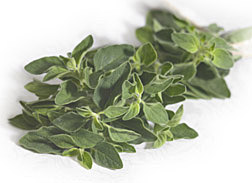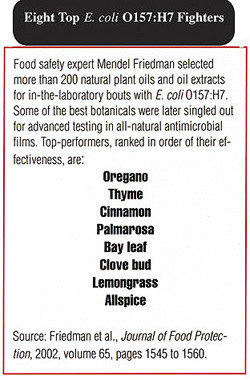Read the
magazine
story to find out more.
|

Extracts from plants such oregano were active
against several foodborne pathogens, including E. coli O157:H7,
Listeria monocytogenes, and Salmonella enterica, in ARS tests.
Photo courtesy of McCormick & Company, Inc.
|

|

|
Spice-Rack Favorites Battle E. coli and Other
Foodborne Pathogens
By Marcia Wood
July 14, 2008 Herbs and spices like oregano, thyme,
cinnamon and clove do more than add pleasing flavors and aromas to familiar
foods. The oils from these plants, or compounds extracted from those oils, pack
a powerful, antimicrobial punch—strong enough to help quell such foodborne
pathogens as Escherichia coli O157:H7.
That's according to Agricultural Research
Service (ARS) chemist
Mendel
Friedman, who several years ago evaluated the bacteria-bashing power of
these and dozens of other plant compounds.
Now, some of the compounds that Friedman and co-investigators determined
were the strongest combatants of E. coli, Salmonella enterica,
Campylobacter jejuni, or Listeria monocytogenes in the
2002 study are being tapped for new research focused on food safety.
For example, Friedman, research leader
Tara H.
McHugh, and other scientists at the
ARS
Western Regional Research Center in Albany, Calif., are evaluating the
highest-ranking botanical bactericides as potential ingredients in what are
known as edible films.
A thin, pliable, edible film for the future might be made of puréed
spinach spiked with carvacrol, the compound responsible for oregano's ranking
as a top fighter of E. coli in the Friedman study.
The scientists want to find out whether adding small squares of
carvacrol-enhanced spinach purée film to bags of chilled, ready-to-eat
spinach leaves would help protect this salad green against E. coli.
Friedman is also exploring other new uses of the top-rated botanicals from
the earlier study. That investigation, which he conducted with technician
Philip
R. Henika and research leader
Robert
E. Mandrell at Albany, was the most extensive of its kind at the time it
was published. Also notable was the common basis of comparison, which the team
established by inventing new methods to prepare and test all of the samples.
For even more consistency, the scientists used the same bacterial
strains—from the same suppliers—throughout the investigation.
Read
more about the research in the July 2008 issue of Agricultural
Research magazine.
ARS is a scientific research agency of the U.S. Department of Agriculture.